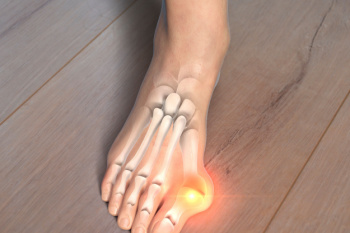

A bunion is a bony bump that forms at the base of the big toe, causing it to lean inward toward the other toes. This condition, also known as hallux valgus, develops gradually and is often aggravated by wearing tight shoes or genetic predisposition. Bunions can lead to pain, swelling, and difficulty fitting into shoes comfortably. Relief methods focus on managing symptoms and preventing further progression. Wearing shoes with a wide toe box and low heels reduces pressure on the bunion. Padded shoe inserts or orthotics can provide additional support and alignment for the foot. If you have developed a painful bunion, it is suggested that you contact this type of doctor who can target specific treatment methods that are right for you, which may include surgery for permanent removal.
If you are suffering from bunions, contact Dr. Harris L. Klear of Burlington County Podiatry Associates. Our doctor can provide the care you need to keep you pain-free and on your feet.
What Is a Bunion?
A bunion is formed of swollen tissue or an enlargement of boney growth, usually located at the base joint of the toe that connects to the foot. The swelling occurs due to the bones in the big toe shifting inward, which impacts the other toes of the foot. This causes the area around the base of the big toe to become inflamed and painful.
Why Do Bunions Form?
Genetics – Susceptibility to bunions are often hereditary
Stress on the feet – Poorly fitted and uncomfortable footwear that places stress on feet, such as heels, can worsen existing bunions
How Are Bunions Diagnosed?
Doctors often perform two tests – blood tests and x-rays – when trying to diagnose bunions, especially in the early stages of development. Blood tests help determine if the foot pain is being caused by something else, such as arthritis, while x-rays provide a clear picture of your bone structure to your doctor.
How Are Bunions Treated?
If you have any questions, please feel free to contact one of our offices located in Marlton and Delran, NJ . We offer the newest diagnostic and treatment technologies for all your foot care needs.